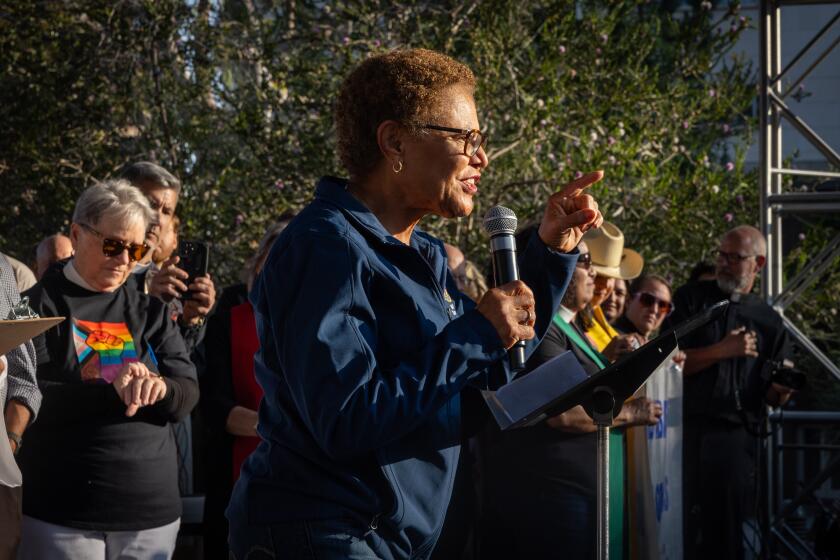In Class and in Prison
- Share via
Imagine a system that determines where a person is placed based on skin color or gang ties or territorial lines. Sound like what happens in the state prison system? It also happens in the high schools of the Los Angeles Unified School District.
When the Los Angeles school system’s busing czar tries to find space for kids crowded out of their neighborhood high schools, he must consider more than bus routes and classroom seats. Is the receiving school a “blue” campus or “red” one -- does it belong to the Crips or the Bloods? A wrong move could disrupt the education of thousands of students on any given day.
In a sign of the pervasive presence of street gangs in this city, the nation’s second-largest school district has been forced to bend to the gangs’ mob-like influence. Police officers patrol all 49 high school campuses. Administrators rely on student informants to warn them when gang feuds are brewing. Student transfer plans are color-coded to keep kids from rival neighborhoods apart, whether or not they are gang members. It is no longer just the locked gates, chain-link fences and metal detectors on campuses that evoke a penitentiary comparison, but the machinations required to blunt the effect of gang rivalries in classrooms and schoolyards.
It’s youth relations counselor Joel Juntilla escorting a 14-year-old with gang ties around his new school, so the “shot-callers” of a resident rival gang can meet him and let Juntilla know whether the kid’s likely to make it through lunch without getting jumped. It’s a San Fernando Valley vice principal turning away a transfer student because he hails from a neighborhood that is at war with a gang whose members already attend the school. It is understanding that you can’t send a Crip to Fremont High; that Jefferson High is home to the Bloods; that kids crowded out of Manual Arts, considered “mostly blue,” will be bused past closer uncrowded schools out to Chatsworth or Taft in Woodland Hills, because Crips are safe on those campuses. It’s a dress code that is dictated by danger: no baggy pants, caps or bandannas, no shoelaces that are red or blue -- nothing that might signal gang ties.
And it’s not a problem confined to the inner city or to black and Latino kids. “We’ve got violent Korean youth gangs, and these are kids earning A’s in school,” said Debbie Leidner, superintendent of the district’s northwest Valley region. “The reality is there is no high school that is free of gangs within the [surrounding] community
This preoccupation with gang affiliation is not new. School attendance boundaries, and even the dividing lines for the system’s governing mini-districts, have been drawn in the past with gang turf claims in mind. But the situation has become more complicated -- and more volatile -- in recent years because of several colliding factors: rapid demographic shifts in the district and accompanying ethnic tensions; overcrowding that sends almost 7,000 high school students to campuses outside their neighborhoods; the territoriality that results from gang control of the narcotics trade; cheap, easy access to guns on the street; and a youth and media culture that glamorizes the gang lifestyle.
Understanding the gang calculus is now part of the equation of being a principal. “You could have a campus of 3,000 kids and you get one or two players [from the wrong gang], and that campus becomes electric,” said Bruce Takeguma, who organizes the district’s busing program. For students, the threat of gang rivalries complicates the most basic decisions and colors the simplest interactions. A small slight -- stepping on someone’s shoe, bumping into a gang member’s girlfriend -- can turn into a major conflagration.
School district officials say they are boxed in by competing agendas: the need to maintain campus safety and the responsibility to give gang members a chance at education. “We make these accommodations with a very clear understanding of what we’re doing,” says Supt. Roy Romer. “We have to run this institution so that every kid has a right to come in this door and get an education.” Yes -- but what kind of message do the district’s tactics convey to hardworking students asked to accept the omnipotence of gangs in order to get an education?
We know that the school district didn’t create the gang problem. But its make-do attitude of managing the situation allows everyone to avoid dealing with the fact that Los Angeles, with an estimated 100,000 gang members, endures the worst gang violence in the nation. It’s a perverse moral argument to suggest that, in the name of keeping kids safe, control be ceded to street gangs to dictate who is allowed to attend which school and who is to be kept away. Sanctioning the segregation only institutionalizes the gangsters’ power. What’s happening in the public high schools of Los Angeles is a direct reflection of the dangerous climate of gang-controlled streets. What’s required from our leaders is not capitulation. What’s called for first is outrage.
More to Read
Sign up for Essential California
The most important California stories and recommendations in your inbox every morning.
You may occasionally receive promotional content from the Los Angeles Times.













